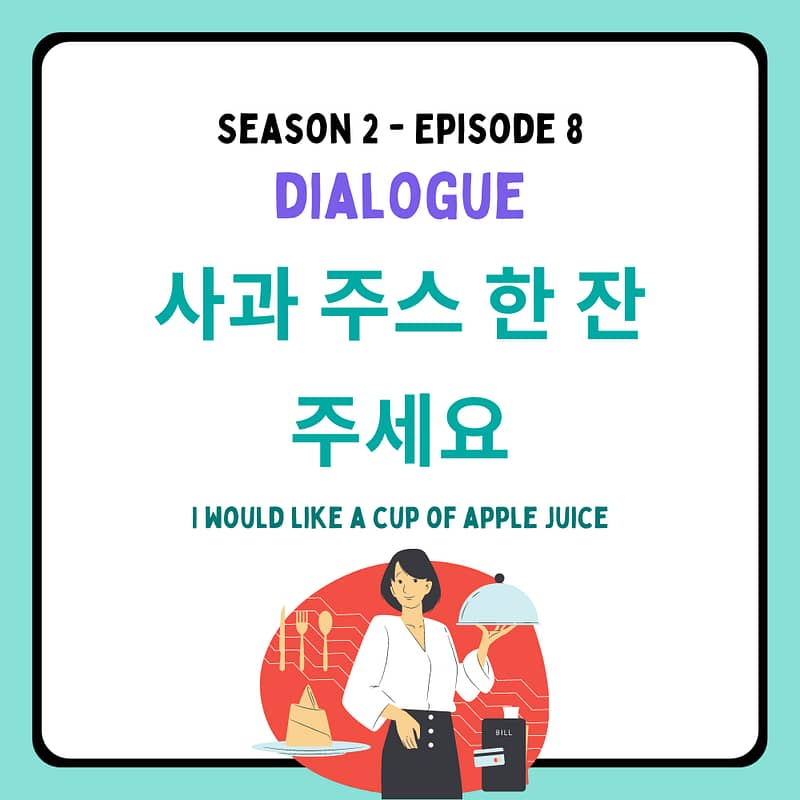Powered by RedCircle
시즌2, 8화. 대화편 | 사과 주스 한잔 주세요.
Season 2, Episode 8 – Dialogue | I’d like a cup of apple juice, please
C: 안녕하세요? Hello?
V: 안녕하세요? 혹시 메뉴판 있어요? Hello? Do you have a menu board?
C: 네, 여기요. Yes, here it is.
V: 감사합니다. 음… 메뉴가 많네요. 혹시 어떤 메뉴를 추천하세요? Thank you. Well… There are many options. What do you recommend?
C: 우리 식당은 불고기 비빔밥 정식이 맛있어요. Our restaurant, the bulgogi bibimbap set meal, is known to be tasty.
V: 아. 그렇군요. 그럼 불고기 비빔밥 정식 1개 주세요. Oh. I See. Then I’ll order one set meal of Bulgogi Bibimbap
C: 마실 것은 뭐로 하시겠어요? What would you like to drink?
V: 저는 그냥 사과 주스 한 잔 주세요. I’ll just have a glass of apple juice.
C: 네. 알겠습니다. All right.
(returning with the food)
C: 여기 불고기 비빔밥 정식 나왔습니다. 맛있게 드세요. Here is the Bulgogi Bibimbap set meal. Bon appetite.
V: 감사합니다. Thank you
C: 혹시 더 필요하신 건 있으세요? Is there anything else you need?
V: 그럼 이 나물 반찬 조금만 더 주실 수 있어요? Then Could you give me a little more of this vegetable side dish?
C: 네. 드릴게요. 여기 있습니다. Sure. I’ll refill it for you. Here it is.
V: 감사합니다. Thank you.
C: 혹시 또 더 필요하신 것 있으세요? Is there anything else you need?
V: 아니요. 괜찮습니다. 감사합니다. No. I’m good. thank you.
(finishing the meal)
V: 계산은 어떻게 하면 돼요? How can I pay for the meal?
C: 계산은 카운터에서 저희 직원이 도와줄 거예요. Our staff will help you with the checkout at the counter.
V: 아. 네. Oh. Yes.
(in the counter)
V: 얼마예요? How much is it?
C: 네, 3만원입니다. 현금, 신용카드, 체크카드 중에 뭘로 계산 하시겠어요? It’s 30,000 won. Would you like to pay with cash, credit or debit card?
V: 신용카드로 계산할게요. I’ll pay by credit card.
C: 네. 알겠습니다. 여기 카드요. Yes. All right. Here’s the card.
V: 네. 감사합니다. 잘 먹었습니다. Yes. Thank you. I really enjoyed the meal.
C: 네 감사합니다. Thank you.
Okay, We heard a dialogue between a staff and a customer in a restaurant.
In this dialogue, we can learn many expressions that may be used in a Korean restaurant. Then now, shall we break down the conversation together?
C: 안녕하세요?
V: 안녕하세요? 혹시 메뉴판 있어요?
C: 네, 여기요.
V: 감사합니다. 음… 메뉴가 많네요. 혹시 어떤 메뉴를 추천하세요?
C: 우리 식당은 불고기 비빔밥 정식이 맛있어요.
V: 아. 그렇군요. 그럼 불고기 비빔밥 정식 1개 주세요.
C: 마실 것은 뭐로 하시겠어요?
V: 저는 그냥 사과 주스 한 잔 주세요.
C: 네. 알겠습니다.
So the woman here was ordering food while the man was a staff in this restaurant helping to take the order from her. Right?
In this part, did you catch to hear the words “메뉴판” and “메뉴”?
Then do you know what the difference between 메뉴판 and 메뉴?
Yes, 메뉴판 is a board that all the menus are written in, while 메뉴 is the foods that are sold in the restaurant. So the customer said 메뉴판 있어요? Do you have a menu board? And 여기 메뉴가 많네요. You have a lot of food options.
And then the customer asked like “어떤 메뉴를 추천하세요?” What do you recommend? And the staff said 우리 식당은 불고기 비빔밥 정식이 맛있어요. It means that the Bulgogi Bibimbop combo set is delicious at our restaurant. But if you see this sentence closely, you can notice that both the topic marking particle and the subject marking particle are used in this sentence, right? Yes, so to be exact, it means, like speaking of our restaurant, the bulgogi bibimbap combo set is delicious. I know it isn’t very clear to decide when to use these two particles. So, see many examples and try to analyze why people use this marking particle here and the other one there. Then you will grasp the concept all of sudden at one point. And if you have some sentences that you don’t understand fully among those in our podcast, leave us a comment on the script article of our website. I will help you to understand it better.
Okay, back to the topic again, and let’s see the rest. The staff said 마실 것은 뭐로 하시겠어요? What would you like to drink? So the customer said “사과 주스 한 잔 주세요.” Please give me a cup of apple juice. 한 잔 means a cup. In Korean, we have many counting units to count the number of things, people, animals, etc. 한 잔 (a cup) is one of those. I will also upload a flashcard for you to practice related expressions on our website. If you want to learn and practice it, go and see the website. And also, as some of you probably know, to count the number in Korean, we use the native number system like 하나, 둘, 셋, 넷, 다섯.
All right, then now let’s move on to the next part
C: 여기 불고기 비빔밥 정식 나왔습니다. 맛있게 드세요.
V: 감사합니다.
C: 혹시 더 필요하신 건 있으세요?
V: 그럼 이 나물 반찬 조금만 더 주실 수 있어요?
C: 네. 드릴게요. 여기 있습니다.
V: 감사합니다.
C: 혹시 또 더 필요하신 것 있으세요?
V: 아니요. 괜찮습니다. 감사합니다.
여기 불고기 비빔밥 정식 나왔습니다. Here comes the Bulgogi Bibimbap combo set. 맛있게 드세요. Bon appetite! 맛있게 드세요’s literal translation is “please eat it deliciously.” The literal translation is a little bit weird, but it conveys the meaning of “enjoy your meal.” Also, let’s see what would 정식 be like more. I translated 정식 into English like a combo set. But it is not served with a cup of coke and french fries. If you order 정식 in a Korean restaurant, you will have a main dish, which it should be 불고기 비빔밥 in this case, and a small portion of soup and couple of side dishes 반찬 such as 김치 or 나물 seasoned vegetables. So if you have a chance to try 정식, try it. It will be very fulfilling.
And then since the staff said 혹시 더 필요하신 것 있으세요? Do you need anything else?, the customer said 그럼 이 나물 반찬 조금만 더 주실 수 있어요? Then can I have more of 나물 반찬? So he said YES. Yes, you can refill side dishes as many times as you can in Korea. It’s Korean culture. So 반찬 side dishes and 물 water are always free in Korea. So you don’t have to hesitate to ask more 반찬 to the staff in Korea. So please don’t be shy and ask them. 🙂
All right, that was a little bit about Korean restaurant culture.
Then now, shall we listen to the last part?
(finishing the meal)
V: 계산은 어떻게 하면 돼요?
C: 계산은 카운터에서 저희 직원이 도와줄 거예요.
V: 아. 네.
(in the counter)
V: 얼마예요?
C: 네, 3만원입니다. 현금, 신용카드, 체크카드 중에 뭘로 계산 하시겠어요?
V: 신용카드로 계산할게요.
C: 네. 알겠습니다. 여기 카드요.
V: 네. 감사합니다. 잘 먹었습니다.
C: 네 감사합니다.
계산은 어떻게 하면 돼요? How can I pay? 계산은 카운터에서 저희 직원이 도와줄 거예요. Our staff will help you with the payment at the counter. Yes. It’s a little bit unfamiliar, right? I know. You pay after the meal at the restaurant’s counter, which in most cases, is right in front of the restaurant’s door. So you will barely have a chance to use the word 계산서 주시겠어요? Can I have a check, please?
You can just go to the counter and pay without noticing the waiters there because you don’t have to pay the tip, either. My husband, who is Korean-American, visited Korea for the first time, went to a restaurant, and left a tip on the table. And what happened next was funny. So the staff there came to my husband and returned the money back to him and said “You left your money on the table” with the face saying “You clumsy!”. Yup, so just don’t try to bother anyone to pay a tip in Korea.
Okay, and then she asked this question “얼마예요? How much is it?” Then he said “네, 3만원입니다. 현금, 신용카드, 체크카드 중에 뭘로 계산 하시겠어요? It’s 30 thousand won. How would you like to pay with among cash 현금, credit card 신용카드, debit card 체크카드?” So she wanted to pay with her credit card 신용카드, right?
And lastly, when she was about to leave the restaurant, what she said was this “잘 먹었습니다. I ate it well” This is an expression that shows you enjoyed the meal. It’s like saying like “It was an enjoyable meal, It was delicious.” If you say this to the restaurant staff in Korea, you will see their big smiles, and it’s more likely for them to remember you.
In Korea, there is a custom called 서비스 between business and customers. The word from the Engish word “Service” but has a different implication. In Korea, the restaurant owner or owner of the business may offer free items when they know you are a regular customer or feel that you are a great customer.
For example, restaurant owners may give you a free or extra appetizer, or other businesses such as cosmetic stores may provide you free lotions and other promotional items that you may like. It is a way to show gratitude to you as the customer. However, don’t expect to receive 서비스 every time you visit because owners might be busy or may not count you as a regular customer yet to receive it.
All right, today we learned the expression used in a restaurant and the unique restaurant cultures in Korea.
Flashcard for studying the counting units in Korean




